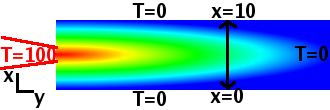| We have separated | $\frac{\partial^2T(x,y)}{\partial x^2}+\frac{\partial^2T(x,y)}{\partial y^2}=0$ | |||
| into | $\frac{{\rm d}^2X(x)}{{\rm d}x^2}=k^2X(x)$ | and | $\frac{{\rm d}^2Y(y)}{{\rm d}y^2}=-k^2Y(y)$ | , |
| where $k^2$ is the separation constant. | ||||
| These are ODE with constant coefficients | ||||
| with the constants: | $a_2=1;\quad a_1=0;\quad a_0=-k^2$ | and | $a_2=1;\quad a_1=0;\quad a_0=k^2$ | . |
| Hence, the roots are: | $k_{1,2}=-0\pm\sqrt{0+\frac{k^2}{1}}=\pm k$ | and | $k_{1,2}=-0\pm\sqrt{0-\frac{k^2}{1}}=\pm {\rm i}k$ | , |
| where ${\rm i}$ is the complex unit. The solutions of the two 1st-order ODE are | ||||
| linear combinations of the two roots: | $X(x)=c_1{\rm e}^{kx}+c_2{\rm e}^{-kx}$ | and | $Y(y)=c_3{\rm e}^{{\rm i}ky}+c_4{\rm e}^{-{\rm i}ky}$ | . |
Bearing in mind that a real exponential is a monotonously decreasing or increasing function while a complex exponential is an oscillating function: ${\rm e}^{{\rm i}kx}=\cos{kx}-{\rm i}\sin{kx}$, the (mathematically) possible solutions of Laplace's equation are
or any linear combination of the above.
Not all of the mathematical solutions make physical sense. The boundary conditions determine which ones are sensible solutions of the physical problem.

The boundary conditions in the example are:
$T(x,\infty)=0$ (right)
$T(0,y)=0$ (bottom)
$T(10,y)=0$ (top)
$T(x,0)=100$ (left)
The first condition, $T(x,\infty)=0$, rules out all those solutions that have an oscillation along the $y$ axis because the temperature profile decays monotonously from left to right. That removes four of the eight solutions:
The same boundary condition also contradicts those solutions that increase rather than decrease along the $y$ axis, i.e. the positive exponentials. So, that's two more gone:
The second boundary condition, $T(0,y)=0$, requires that the oscillating function along $x$ is zero at $x=0$. Therefore, of the remaining two solutions, we can rule out the one with a cosine term:
We can use the third boundary condition, $T(10,y)=0$, to put constraints on the constant $k$. Inserting the BC into the one remaining general solution, we have $${\rm e}^{-ky}\sin{10k}=0\qquad.$$ The LHS is equal to zero if either of the factors is zero. The exponential is only zero in the limit of infinite $y$; the roots of the sine factor are $k=\frac{n\pi}{10}$, where $n$ can be any integer number.
Therefore, the physical solution must be of the form $$T(x,y)={\rm e}^{-\frac{n\pi}{10}y}\sin{\frac{n\pi}{10}x}$$ or any linear combination of such terms. A linear combination of all possible terms with $n=1,2,3,\dots$ (with linear coefficients $b_n$) is $$T(x,y)=\sum_{n=1}^{\infty}b_n{\rm e}^{-\frac{n\pi}{10}y}\sin{\frac{n\pi}{10}x}\qquad.$$ This is a Fourier sine series, and we can find its coefficients by applying the final boundary condition and integrating.
In order to continue solving Laplace's equation, we first need to find out how to determine the Fourier coefficients.